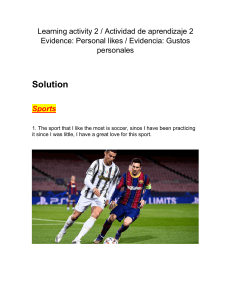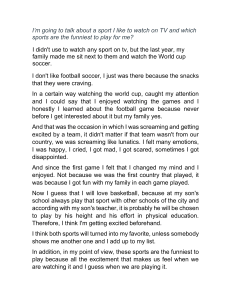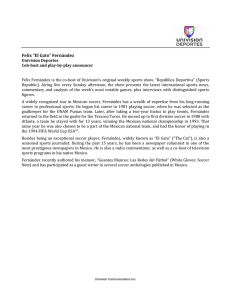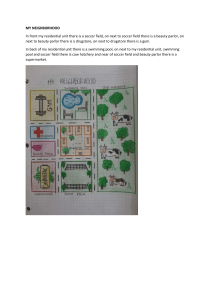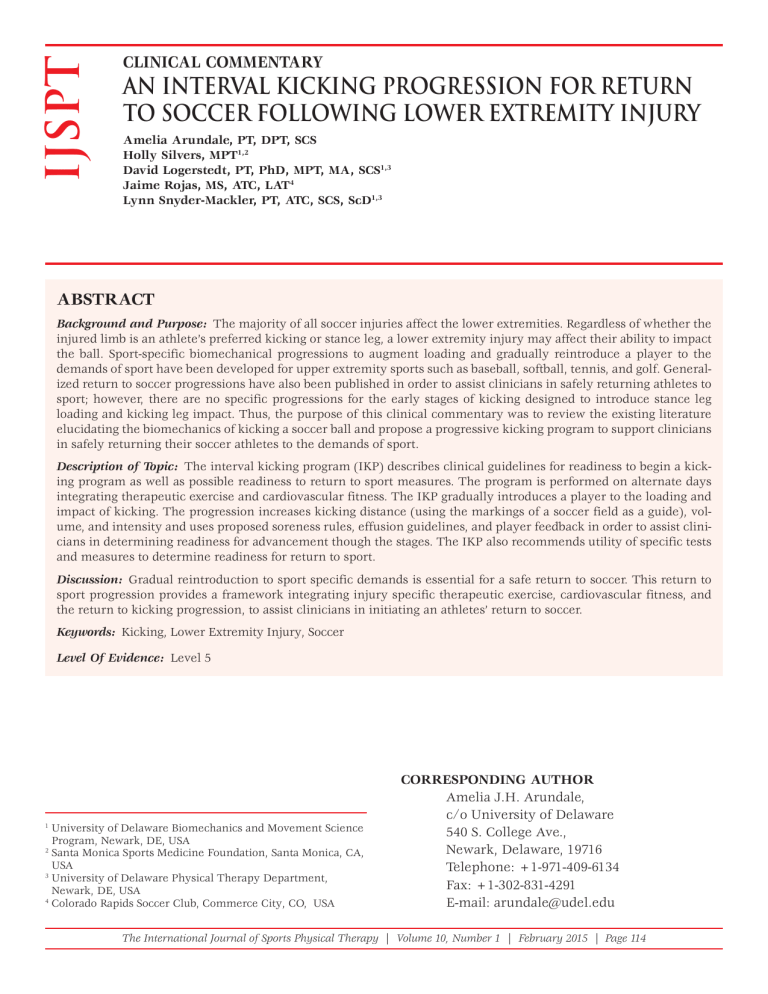
IJSPT CLINICAL COMMENTARY AN INTERVAL KICKING PROGRESSION FOR RETURN TO SOCCER FOLLOWING LOWER EXTREMITY INJURY Amelia Arundale, PT, DPT, SCS Holly Silvers, MPT1,2 David Logerstedt, PT, PhD, MPT, MA, SCS1,3 Jaime Rojas, MS, ATC, LAT4 Lynn Snyder-Mackler, PT, ATC, SCS, ScD1,3 ABSTRACT Background and Purpose: The majority of all soccer injuries affect the lower extremities. Regardless of whether the injured limb is an athlete’s preferred kicking or stance leg, a lower extremity injury may affect their ability to impact the ball. Sport-specific biomechanical progressions to augment loading and gradually reintroduce a player to the demands of sport have been developed for upper extremity sports such as baseball, softball, tennis, and golf. Generalized return to soccer progressions have also been published in order to assist clinicians in safely returning athletes to sport; however, there are no specific progressions for the early stages of kicking designed to introduce stance leg loading and kicking leg impact. Thus, the purpose of this clinical commentary was to review the existing literature elucidating the biomechanics of kicking a soccer ball and propose a progressive kicking program to support clinicians in safely returning their soccer athletes to the demands of sport. Description of Topic: The interval kicking program (IKP) describes clinical guidelines for readiness to begin a kicking program as well as possible readiness to return to sport measures. The program is performed on alternate days integrating therapeutic exercise and cardiovascular fitness. The IKP gradually introduces a player to the loading and impact of kicking. The progression increases kicking distance (using the markings of a soccer field as a guide), volume, and intensity and uses proposed soreness rules, effusion guidelines, and player feedback in order to assist clinicians in determining readiness for advancement though the stages. The IKP also recommends utility of specific tests and measures to determine readiness for return to sport. Discussion: Gradual reintroduction to sport specific demands is essential for a safe return to soccer. This return to sport progression provides a framework integrating injury specific therapeutic exercise, cardiovascular fitness, and the return to kicking progression, to assist clinicians in initiating an athletes’ return to soccer. Keywords: Kicking, Lower Extremity Injury, Soccer Level Of Evidence: Level 5 1 University of Delaware Biomechanics and Movement Science Program, Newark, DE, USA 2 Santa Monica Sports Medicine Foundation, Santa Monica, CA, USA 3 University of Delaware Physical Therapy Department, Newark, DE, USA 4 Colorado Rapids Soccer Club, Commerce City, CO, USA CORRESPONDING AUTHOR Amelia J.H. Arundale, c/o University of Delaware 540 S. College Ave., Newark, Delaware, 19716 Telephone: +1-971-409-6134 Fax: +1-302-831-4291 E-mail: arundale@udel.edu The International Journal of Sports Physical Therapy | Volume 10, Number 1 | February 2015 | Page 114 INTRODUCTION Approximately 265 million people play soccer, making it the most popular sport in the world.1 Unfortunately, the demands of the sport place the lower extremities at high risk for injury.2,3 Sport-specific biomechanical progressions can augment loading, reducing the risk of re-injury as an athlete attempts to return to sport. Interval programs, integrated as part of a return to sports progression, gradually expose upper extremity athletes to the demands of their sports as they return to baseball, softball, golf, and tennis.4-6 Similarly, interval running programs are also common, gradually reintroducing the biomechanical and cardiovascular demands of running.7,8 However, to the authors’ knowledge there are no published interval kicking programs to prepare soccer players for return to sport after sustaining a lower extremity injury. Therefore, the purpose of this clinical commentary was to examine the existing literature relevant to kicking in soccer and propose an interval kicking program (IKP) that can be used as a framework to return an athlete to kicking a soccer ball following lower extremity injury. INJURIES IN SOCCER Injuries occur at a rate of 8.0 per 1000 player hours in European men’s professional soccer for an average of two injuries per player per season,2,9 which for a team of 25 players, translates to 50 injuries of varying severity per season, resulting in significant medical costs, diminished club performance, and lost playing time. Between 60-87% of soccer injuries involve the lower extremities.2,3,10 The majority of injuries are acute or traumatic,11 with chronic or reinjures accounting for only a small proportion of all injuries.3,10,12 Approximately 57-80%2,9,11,12 of injuries occur in matches, up to one quarter of these2,11,13 stemming from foul play. These rates of injury are similar for amateur and youth players. Among youth players injury incidence increases with age, women between the ages of 15-19 having the highest incidence.14-16 Goalkeepers at all levels have a lower injury incidence than field players.14,17-19 Studies examining soccer injury incidence indicate that injuries occur more frequently in games than in training sessions,2,3,10,11,13 but some professional leagues have unique patterns of injury occurrence across a season. In European men’s professional soccer, for instance, injury occurrence increases both in the latter portion of the season and when game frequency increases.2,9,10 Women’s professional soccer in Germany shows a similar trend, with a higher overall number of injuries occurring in the second half of the season.13 In contrast, injury occurrence in US men’s professional soccer spikes twice, once early in the season and then again in mid to late season.19 Muscle strains account for 31% of all injuries in women’s soccer,10 and approximately 35% in men’s soccer.2 In men’s soccer the risk of muscle injury increases with age,12,17,20 history of injury,12 and during the later portions of a game.20 Injuries to the thigh region are the most common, with hamstrings strains accounting for 16% of all reported injuries.2,3,9 The adductors are the next most commonly injured muscle group, followed by quadriceps and calf muscles.9 Furthermore, patterns of injury occurrence vary by muscle group, with adductor strains stemming from overuse rather than trauma.20 Quadriceps strains are more commonly seen on the kicking leg,20 often occurring during preseason, in contrast to adductor and calf injuries which occur later in the season.12 In European men’s professional soccer, hamstrings injuries are sustained more commonly late in the season,20 whereas in US men’s professional soccer hamstrings injuries are reported more often early in the season.19 Ligament sprains make up a smaller portion of all injuries; 19.1% in women’s soccer10 and 18% in men’s soccer.2 In men’s soccer the majority of these sprains occur at the ankle, representing 51% of all sprains and 6.9-7.5% of all injuries.3,9,10 Knee sprains are less common than ankle sprains in both men’s and women’s soccer, though often more serious. In men’s soccer, isolated medial collateral ligament (MCL) sprains are the most common knee ligamentous injury,2,9 in contrast to women’s soccer where anterior cruciate ligament (ACL) injuries are the most common. ACL injuries are a significant problem in women’s soccer, with injuries in professional soccer occurring at a rate of 0.09 per 1000 playing hours10 and between 0.1-0.31 per 1000 playing hours in amateur and collegiate soccer.14,21-24 The risk of ACL injury for adolescent female players has been reported to be even higher, at 1.0 per 1000 playing hours.25 The International Journal of Sports Physical Therapy | Volume 10, Number 1 | February 2015 | Page 115 Lower extremity injuries may affect the kinematics of kicking, as the kicking leg requires adequate range of motion (ROM), muscle strength, and neuromuscular control in order to move through the kicking motion, in addition to having the stability to withstand and dissipate the impact force of striking a ball. The health of the stance leg is of equal importance, as its ROM, strength and neuromuscular control are essential to stabilizing the body throughout the kicking motion. Regardless of whether the injury involved the stance or the kicking limb, both limbs should be analyzed for pathokinematic patterns potentially involved in the development of the initial injury. OVERVIEW OF KICKING BIOMECHANICS The three common kicking techniques in soccer are the instep kick, the curved kick (a variation of the instep kick which generates ball spin and a curved flight pattern of the ball), and the side-foot kick. During an instep kick (Figure 1b) a player strikes the ball with the laces of the shoe, along the first metatarsal. In contrast, during a side-foot kick (Figure 1a) a player uses the medial side of the foot, striking the ball with the medial arch. Brophy et al describe five phases of kicking (Table 1 and Figure 2) that are proportionally the same duration for instep and side-foot kicking; however, instep kicks occur at a higher velocity.26 Other important soccer-specific techniques include dribbling, volleying, and juggling (for additional detail see Appendix 1). Dribbling is the use of numerous small touches of the ball with the foot/ feet allowing a player to run with the ball at his or her feet. Players generally use the distal lateral dorsum of the foot to push the ball, though all surfaces of the foot can be used, especially when attempting to evade a defender. Volleying is a technique using the side or instep of the foot in order to strike a lofted or airborne ball. Juggling uses the feet, thighs, chest, head, and occasionally other body parts to Figure 1. Example of Side-foot and Instep kick. a.) Side-foot kick: A kick using medial side of the foot, particularly the medial arch, to strike the ball. b.) Instep kick: A kick using the dorsum of the foot, particularly along the first metatarsal, to strike the ball. Both techniques can be used for short or long distance kicking, however the instep kick is more frequently used for long distances and/or higher speeds. The International Journal of Sports Physical Therapy | Volume 10, Number 1 | February 2015 | Page 116 Table 1. The Start and End Point of the Phases of Kicking Phase 1 2 Preparation Backswing 3 Leg Cocking 4 Start of phase* Heel strike Toe-off Maximum hip extension Maximum knee flexion Ball contact Leg Acceleration 5 Follow Through *Events all occur on the kicking leg. End of phase* Toe-off Maximum hip extension Maximum knee flexion Ball contact Heel strike keep the ball in the air. Rarely used in games, juggling is commonly used to practice controlled and accurate touches of the ball. In addition to each of the aforementioned techniques, Goalkeepers use one additional technique which will not be covered in this paper, the drop-kick or punt. The drop-kick is similar to that used in Aussie Rules Football, rugby, or American football, though there are slight variations due to the shape of the ball. Players often take two to four steps at an angle of 42-45⬚27,28 leading up to a kick (with the last step being the longest, particularly for long-range kicks29,30) with their bodies inclining posteriorly and laterally towards the side of the support leg by 25⬚ (Figure 2: Preparation).31 This angle of approach coupled with the angle of the support leg facilitates a steeper swing plane for the kicking leg, allowing greater extension of the kicking leg at ball contact, thereby creating higher foot velocities and better ball contact, as well as a more stable support-leg position.32 At backswing the arm of the support leg is abducted and gradually adducts as the body moves through leg cocking and leg acceleration (Figure 2: Backswing). The trunk also rotates in preparation for the kick, returning to neutral as the athlete progresses towards the ball.33 Elevation of the arm has been hypothesized as a technique for providing a counterbalance to stabilize the body or for creating an arc of tension to use potential energy. The arc is created by increased tension from abduction of the arm, rotation of the trunk, and extension of the hip in backswing. Through a stretch shortening cycle potential energy is converted as the leg swings forward and arm adducts.32,33 Skilled players use a greater hip and arm range of motion, allowing them to create greater ball speeds without expending additional energy.33 Pelvic protraction and posterior tilting occurs as the body progresses towards ball contact. During backswing, the pelvis of the kicking leg begins lowered relative to the support leg and rises to a position superior to the support leg at ball contact facilitating greater knee extension of the kicking leg, greater foot speed (Figure 2: Backswing, Leg Cocking, Leg Acceleration),32,34 and avoidance of catching the toes on the ground.35 Brophy et al report that women have significantly more hip adduction on the support leg than men, particularly during backswing, leg cocking, and leg acceleration; however, overall pelvic obliquity remains the same.36 At the beginning of backswing, the support leg knee is flexed at approximately 26° and continues flexing until ball contact in order to absorb the force of landing and provide stability (Figure 2: Backswing, Leg Cocking, Leg Acceleration). Immediately following ball contact the knee begins to extend slowly, allowing for stability, muscle fiber recruitment, and the generation of additional force (Figure 2: Follow Through).37 This eccentric action of the quadriceps during most of the stance phase allows the stance leg more stability and thus generation of greater kicking speed.35 During an instep kick the hip is the primary mover, contributing more to the angular acceleration of the shank than the knee.38 In a side-foot kick, however, Figure 2. The Phases of Kicking The International Journal of Sports Physical Therapy | Volume 10, Number 1 | February 2015 | Page 117 the knee has higher power, likely due to the effort required at the hip to maintain the foot position.38 A strong relationship exists between foot-swing velocity and resultant ball velocity. The findings of Nunome et al indicating that the foot continues to accelerate through ball contact39 are consistent with traditional coaching advice to “kick through the ball.”32 Ball impact lasts 10ms and occurs near the center of gravity of the foot.39 For a ball moving at 16.3 m/s the peak impact force at the foot is 1200N,40 but peak foot impact force can reach as high as 2900N.41,42 Upon impact the foot is passively plantarflexed (unless barefoot, in which case the foot is already in maximal plantar flexion),42 everted and abducted.32,42 Men experience less plantar flexion angular displacement during ball impact than women.42 Some studies have reported men also achieve higher average ball velocities36,43 and ball-to-foot velocity ratios.43 This may be due to smaller plantar flexion displacement, such a mechanism would be similar to the higher velocities achieved when kicking barefoot as compared to shod. Nevertheless, because there is no normative data on kicking, further research is needed in order to fully understand all mechanics involved in this action. Instep kick ground reaction forces (GRF) through the stance leg have been reported as follows: vertical GRF 2.1-2.4 times the player’s body weight (xBW),31,44 posterior GRF 1.9-2.4 xBW, and medial GRF 0.5-1.2 xBW.45,46 The vertical and posterior GRFs of kicking are larger than running at a speed equivalent to the approach steps (vertical 1.7 xBW, posterior 0.39 xBW).35 Instep kick vertical GRF is smaller than that observed in other sporting activities such as javelin throwing,47 basketball layup or jump shot landing,48 and cricket fast bowling.35,49 Muscle activity varies by muscle group as well as by leg (Tables 2 and 3).26 A side-foot kick requires greater hamstrings activation (62% of maximal volitional isometric contraction-MVIC) during follow through than an instep kick (50% MVIC), while the instep kick requires greater overall iliacus, vastus medialis, gastrocnemius, and adductor activation (Tables 2 and 3). On the support leg, a side foot kick requires higher gastrocnemius activation (84% MVIC) during leg acceleration than an instep kick (74% MVIC).26 Overall, men have greater gluteus medius (124% MVIC) and vastus medialis (139% MVIC) muscle activation (women have 55% MVIC and 69% MVIC respectively) on their support limb and greater iliacus activation (123% MVIC) on their kicking limb as compared to women (34% MVIC).36 Although greater iliacus activation may be protective at the knee it may contribute to a higher risk of Table 2. Muscle activity as a percent of maximal volitional isometric contraction (% MVIC) as measured by electromyography during each phase of an instep kick based on data from Brophy et al (2007). % MVIC Preparation Backswing Leg Cocking 57 46 104 74 148 65 63 30 60 37 128 37 99 14 96 17 75 84 74 78 39 72 36 38 23 60 33 40 149 30 57 109 73 99 26 104 50 93 78 202 42 75 Iliacus Gluteus Medius Gluteus Maximus Hamstrings Vastus Lateralis Vastus Medialis Gastrocnemius Kicking Leg Support Leg 010% 010% 1120% 1120% 2130% 2130% 3140% 3140% 4150% 4150% 5160% 5160% 6170% 6170% Leg Acceleration 131 36 71 119 114 94 33 94 87 107 100 228 57 70 7180% 7180% 8190% 8190% 91100% 91100% Follow Through 95 30 89 82 129 70 50 64 52 49 69 90 67 41 >101%* >101%* *Values greater than 100% represents muscle activity that exceeded measured during maximal volitional isometric contraction The International Journal of Sports Physical Therapy | Volume 10, Number 1 | February 2015 | Page 118 Table 3. Muscle activity as a percent of maximal volitional isometric contraction (% MVIC) as measured by electromyography during each phase of a side-foot kick based on data form Brophy et al (2007) % MVIC Iliacus Gluteus Medius Gluteus Maximus Hamstrings Vastus Lateralis Vastus Medialis Gastrocnemius Kicking Leg Support Leg 010% 010% Preparation Backswing Leg Cocking 28 51 100 73 127 59 59 26 48 34 115 38 82 12 65 19 63 70 57 59 35 78 24 28 15 54 22 32 128 34 72 103 77 109 20 108 58 87 50 182 19 84 1120% 1120% 2130% 2130% 3140% 3140% 4150% 4150% 5160% 5160% 6170% 6170% 7180% 7180% Leg Acceleration 106 37 106 114 115 96 41 74 90 96 99 228 34 56 8190% 8190% 91100% 91100% Follow Through 95 26 82 79 120 69 62 55 47 57 71 99 68 37 >101%* >101%* *Greater than 100% represents muscle activity greater than that measured during maximal volitional isometric contraction hip and groin pathology.36 Hip extension during an instep kick not generated from higher gluteus maximus activation, may necessitate increased iliacus activation in order to flex the hip farther and faster.26 Greater foot speeds and ball speeds are achieved kicking with the dominant leg;35,50 however, there are no differences between the dominant and nondominant limbs in support limb vertical, braking, or medial-lateral GRF.35 The linear velocity of the kicking leg knee is similar, for both the dominant and non-dominant leg, but the shank angular velocity is greater on the dominant leg, meaning more work is done on the shank of that leg.50 In any case, there is no difference in muscle moment or rate of force development.50 Clagg et al found that women kicking with their non-dominant leg used greater amounts of braking torque (hip, knee, and ankle extension, external rotation, and abduction); in contrast, greater pulling torque (flexion, internal rotation, and adduction) was exerted when kicking with their dominant leg.51 While there seems to be little kinematic differences between the dominant and non-dominant legs when kicking a stationary ball as compared to a rolling ball, further research is needed to assess kinetic differences.52 PROPOSED CLINICAL MEASURES Although some objective measurements related to kicking exist, many are not relevant to an IKP. Thus, the authors have separated clinical measures into two categories; readiness for a return to kicking program and readiness for return to sport. Readiness for a return to kicking program: Because the IKP is designed to be performed in conjunction with rehabilitation and cardiovascular training it should only be initiated when an athlete has been cleared to begin running, cutting, pivoting, and sport-specific rehabilitation. Athletes should have no pain, full range of motion, and no effusion as measured by reliable techniques such as the Modified Stroke Test53 for the knee or the Figure 8 circumferential measurement method for the ankle.54 There are currently no valid/reliable tests for measurement of effusion in the hip. Muscle strength, if measured by manual muscle testing should be equal bilaterally. Due to the decreased sensitivity of manual muscle testing as an accurate determinant of strength, the authors recommend quantifying muscle strength using hand-held or electromechanical dynamometers.55,56 Eighty percent strength performance of the involved limb (compared to the The International Journal of Sports Physical Therapy | Volume 10, Number 1 | February 2015 | Page 119 performance of the uninvolved limb) is recommended as a goal when considering readiness for running, a gradual initiation of light plyometric (e.g. hopping), agility, and return to sport activities.57,58 Because running is integral to the lead steps of a kick and the GRFs of kicking are slightly larger than those of running,35 it is critical that an athlete be able to run with even step lengths and without pain prior to kicking. Step length and impact forces should be assessed for symmetry either clinically, by visually examining step symmetry and ball speed, or if available in a laboratory. Readiness for return to sport: The decision to allow an athlete to return to full team training sessions, contact, and eventually game-play is multifactorial, and, all too often made with few or no objective measures. Objective measures, particularly those with normative values, are essential for making an informed decision concerning an athlete’s readiness. While many objective criteria for return to sport have been discussed in the literature there is little agreement on standardization, thus many institutions and practitioners use their own criteria or some combination of criteria. The authors recommend that before returning to full team training with contact an athlete should meet objective criteria that include both performance-based and patient reported outcome measures. An example of such criteria used after ACL injury or surgery is greater than or equal to 90% (performance of the involved limb compared to the performance of the uninvolved limb) on the single, triple, and cross-over hop for distance and the 6-meter timed hop test; greater than or equal to 90% isokinetic quadriceps strength; and a score of greater than or equal to 90% on the Global Ratings Scale, and Knee Outcomes Survey- Activities of Daily Living Scale (KOS-ADLS).58,59 Patient reported outcome measures are important objective tools in order to understand a players’ perceived function. Some measures helpful in assessing function include: the Global Ratings of Change Scales,60 Knee Injury and Osteoarthritis Outcomes Scale (KOOS) (particularly the sports subscale),61,62 the International Knee Documentation Committee 2000 Subjective Knee form (IKDC2000),63 and the Foot and Ankle Ability Measure.64,65 Further, scales that assess kinesiophobia, such as the Modi- fied Tampa Scale of Kinesiophobia-11 (TSK-11),66 or confidence and risk appraisal, such as the Anterior Cruciate Ligament-Return to Sport after Injury Scale (ACL-RSI),67 may also be valuable in assessing an athlete’s readiness and likelihood to return to sport.68 By comparing a player’s current scores to baseline scores and normative data, these self-report measures can allow the rehabilitation team to judge a player’s progress as well as readiness for sport. Numerous assessments of passing, shooting and kicking are available to assess an athlete’s ability to perform soccer-specific tasks. Yet because of the speed of play, the pressure from opponents, and the endurance soccer requires it is difficult to create an objective measure that accurately captures the behavior, accuracy, or performance of a player in competition. Furthermore, many soccer tests require prohibitive amounts of equipment, space, and player/tester training. Two of the most researched tests are the Loughborough Soccer Passing Test and Loughborough Soccer Shooting Test. These were the first, and currently only, tests validated for adolescents and women.69,70 The Loughborough Soccer Passing Test is used to assess a player’s performance when fatigued, as well as a player’s perception and cognitive decision making processes.71 No normative data exists on either test and no validated “passing” cut-off score has been established. Similar to its use in assessing the performance of a baseball pitcher, a radar gun can determine the velocity of a kicked ball, providing information on a player’s ability to contact the ball and whether or not pain occurred. This measure requires baseline data for comparison, and is not generalizable to either practice or game play. Due to the limited use of juggling in an actual game, counting the number of times a player can juggle, has poor construct validity;72 similarly counting the times a player can volley a ball against a wall without its hitting the ground can be used to assess passing accuracy and control, but lacks ecological validity.72 Testing a player’s ability to dribble in a figure eight pattern is a valid and reliable indicator of technique.72 In the case of return to kicking, such a test could be used to assess speed, agility and readiness for higher level dribbling activities. Other soccer-specific tests include shooting at a plywood target covered in carbon paper. Though The International Journal of Sports Physical Therapy | Volume 10, Number 1 | February 2015 | Page 120 a reliable measure of accuracy,73 this test is limited because it requires extensive equipment. Russell et al developed a reliable and valid measure of ball speed and precision involving dribbling, passing, and shooting.74 The test has more reliability than the Loughborough Soccer Shooting Test, but is complex in administration requiring both player and tester training.74 Finally, a qualitative assessment of a player’s actual performance during kicking is crucial both during the IKP and prior to return to sport. Knowledge of a player’s prior abilities and playing style is useful, but general knowledge of what a soccer kick should look like is sufficient to observe for antalgic gait or abnormal movement patterns. In a highly competitive atmosphere this qualitative assessment should be performed by unbiased individuals whose primary concern is the player’s health rather than a timeline for their expected return to playing. THE INTERVAL KICKING PROGRAM The IKP is designed to be performed in conjunction with rehabilitation exercises and cardiovascular training. Della Villa et al75 and Bizini et al76 provide examples of broad return to soccer progressions within which the IKP could be integrated. Systematic progression through the IKP (Table 4) should be individualized and based on a player’s response, feedback and injury. In particular, soreness of the surrounding musculature, is to be expected after initiating a kicking program and the proposed soreness rules should be observed in order to determine readiness for progression (Table 5).6 Similarly, effusion guidelines such as those in White et al58 should also guide progression. Clinicians may also adapt the IKP based on a player’s injury. For example, a clinician may decrease the number or the intensity of side-foot kicks performed by a player recovering from a MCL injury or adductor strain where as a player with deltoid ligament injury or iliopsoas/rectus femoris strain may require an even more gradual introduction to in-step kicking. Similar to upper extremity interval sports programs the IKP is designed to be performed on alternate days.4 The IKP, injury specific strengthening, plyometrics, and neuromuscular control drills should be performed on one day and cardiovascular training and core strengthening performed on the off days. This alternating structure is designed to allow the lower extremities to recover from the re-introduction of kicking, therapeutic exercises, and any plyometric or neuromuscular drills completed. The authors recommend that the IKP be performed prior to other exercises so that it is performed prior to the lower extremities becoming fatigued and to ensure proper form. Swimming, pool running, cycling, or AlterG treadmill running can be used for cardiovascular conditioning to decrease the repetitive impact of running. A soccer ball should be integrated into exercises at the initial stages of rehabilitation. Once an athlete can demonstrate proper biomechanical movement in basic and simulating exercises, adding a ball increases degree of difficulty. Activities such as single-leg balance while gently pushing a ball anteriorly-posteriorly or medially-laterally with the contralateral foot, are low risk/low force exercises that help progress a player’s proprioception while maintaining touch/feel for the ball. Incorporating heading, or in the case of goalkeepers catching/throwing, can also make rehabilitation exercises sport specific and enjoyable. Further, soccer related exercises may improve an athlete’s mood, confidence, and motivation; all factors linked to a higher likelihood of an athlete returning to sport.68 When a player is deemed ready to begin the IKP it is crucial that all kicking techniques are performed with proper biomechanics. Coaches may aid the rehabilitation team in observing a player’s ability with respect to length of passes, lofting balls, and shooting in order to preclude abnormal compensation patterns from being learned, adopted, or reinstituted. A player should perform the IKP in soccer-specific cleats or shoes, as shoes designed for running often have a larger, more elevated sole that may impede stability in landing on the support foot thereby placing the ankle and knee at risk for injury. A soccer ball is required to perform the IKP, but multiple balls are recommended as this allows for more continuous kicking as opposed to time spent retrieving balls. The IKP is based on soccer field distances (Appendix 2), thus performing on a lined a soccer field will reduce set up time. A goal is also useful for the later stages when a player resumes shooting. The International Journal of Sports Physical Therapy | Volume 10, Number 1 | February 2015 | Page 121 Table 4. The Interval Kicking Program The International Journal of Sports Physical Therapy | Volume 10, Number 1 | February 2015 | Page 122 Table 4. The Interval Kicking Program (continued) Table 5. Proposed Soreness Rules for Progression through the Interval Kicking Program, adapted from Axe et al (2001). If no soreness: If sore during warm-up but soreness is gone during dribbling and juggling warm-up: If sore during warm-up and soreness continues through dribbling and juggling warm-up: If sore more than 1 hour after kicking, or the next day: Advance to next stage Repeat previous stage. Stop; take 2 days off, and upon return to IKP, drop down one stage Take 1 day off; repeat most recent stage. The International Journal of Sports Physical Therapy | Volume 10, Number 1 | February 2015 | Page 123 Proper warm-up of the muscles and cardiovascular system is necessary; the authors recommend a dynamic warm-up that integrates stretching, low-level strengthening, and movement. The FIFA 11+ is a soccer-specific warm-up developed as an injury prevention tool.77 The FIFA11+ is designed to warm up all of the major muscle groups in the lower extremity, and can serve also as a teaching tool to reinforce proper alignment and mechanics. Proper cool-down is also important following performance of the kicking program. This may include stretching, light jogging, and cryotherapy. Position specific modifications: Unlike rehabilitation in sports such as baseball and softball, little position-specific rehabilitation is needed in soccer. Goalkeepers must be confident and skillful with a ball at their feet, thus in these initial stages of returning to soccer the IKP is as important for goalkeepers as it is for field players. The rehabilitation team may modify later stages of the kicking program for goalkeepers, omitting shooting in favor of similar distance goal kicks (long/lofted instep kicks) or punts. Goalies may also add jumping, catching, diving for and retrieving balls from the air as part of their dribbling or juggling warm-ups. One example of an alternative for goalkeepers is side shuffling along a line 11m long. Each time the goalkeeper reaches the end of the line they receive either a ball on the ground, which they must pass back with their feet, or a ball in the air, which they must catch and throw back. Adding plyometric and diving activities, however, is at the discretion of the rehabilitation team. The cardiovascular and intensity demands of soccer differ by position. During games mid-fielders, often wide midfielders, cover the most distance of any field player and cover the most distance at high speeds.78,79 In contrast, central defenders cover the least distance and least distance at high intensities.78,79 Attackers and central defenders may also have more recovery time between their bouts of high intensity.78 Consequently the rehabilitation team should modify cardiovascular training to prepare a player for return to sport taking into consideration position, fitness prior to injury, and age. CONCLUSION Regardless of whether an injury effects an athlete’s dominant kicking or stance leg, any lower extrem- ity injury may influence the ability to kick. The IKP presents a novel return to kicking framework specific to the sport of soccer. Similar to return to throwing progressions developed for athletes in upper extremity sports,4-6 this return to kicking progression guides clinicians from readiness to begin kicking through an athlete’s return to sport. The IKP format integrates a return to kicking into therapeutic exercise and cardiovascular fitness in order to address the broader needs of an athlete. While the IKP presents a starting point for athletes to begin their return to soccer, future research is needed to determine the optimal rehabilitation techniques and additional outcome measures and criteria that will ensure a safe return to sport. REFERENCES 1. Kunz M. 265 million playing football. FIFA Magazine. Zurich: FIFA; 2007. 2. Ekstrand J, Hägglund M, Waldén M. Injury incidence and injury patterns in professional football: the UEFA injury study. Br J Sports Med. 2011;45(7):553558. 3. Waldén M, Hägglund M, Ekstrand J. UEFA Champions League study: a prospective study of injuries in professional football during the 2001–2002 season. Br J Sports Med. 2005;39(8):542-546. 4. Reinhold M, Wilk, K., Reed, J., Crenshaw, K., Andrews, J.,. Interval sports programs: guidelines for baseball, tennis, and golf. J Orthop Sports Phys Ther. 2002;32(6):293-298. 5. Axe MJ, Snyder-Mackler L, Konin JG, Strube MJ. Development of a distance-based interval throwing program for Little League-aged athletes. Am J Sports Med. 1996;24(5):594-602. 6. Axe M, Wickam, R., Snyder-Mackler, L. Data-based interval throwing progams for little league, high school, college, and professional baseball pitchers. Sports Med Arthrosc. 2001;9:24-34. 7. Law 1 The field of play; metric measurements. The Laws of the Game 2013; http://www.fifa.com/ aboutfifa/footballdevelopment/technicalsupport/ refereeing/laws-of-the-game/law/newsid=1285960. html. Accessed January 4, 2014. 8. Manal TJ, Snyder-Mackler L. Practice guidelines for anterior cruciate ligament rehabilitation: a criterionbased rehabilitation progression. Oper Tech Orthop. 1996;6(3):190-196. 9. Ekstrand J, Hägglund M, Kristenson K, Magnusson H, Waldén M. Fewer ligament injuries but no preventive effect on muscle injuries and severe The International Journal of Sports Physical Therapy | Volume 10, Number 1 | February 2015 | Page 124 10. 11. 12. 13. 14. 15. 16. 17. 18. 19. 20. 21. 22. 23. injuries: an 11-year follow-up of the UEFA Champions League injury study. Br J Sports Med. 2013;47(12):732-737. Giza E, Mithöfer K, Farrell L, Zarins B, Gill T. Injuries in women’s professional soccer. Br J Sports Med. 2005;39(4):212-216. Hägglund M, Waldén M, Ekstrand J. UEFA injury study—an injury audit of European Championships 2006 to 2008. Br J Sports Med. 2009;43(7):483-489. Hägglund M, Waldén M, Ekstrand J. Risk factors for lower extremity muscle injury in professional soccer: The UEFA injury study. Am J Sp Med. 2013;41(2):327-335. Faude O, Junge A, Kindermann W, Dvorak J. Injurieortss in female soccer players: A prospective study in the german national league. Am J Sports Med. 2005;33(11):1694-1700. Giza E, Micheli LJ. Soccer injuries. Med Sci Sports Exerc. 2005;49:140-169. Soderman K, Adolphson J, Lorentzon R, Alfredson H. Injuries in adolescent female players in European football: a prospective study over one outdoor soccer season. Scand J Med Sci Sports. 2001;11(5):299-304. Maehlum S, Daljord OA. Football injuries in Oslo: a one-year study. Br J Sports Med. 1984;18(3):186-190. Kristenson K, Walden M, Ekstrand J, Hagglund M. Lower injury rates for newcomers to professional soccer: a prospective cohort study over 9 consecutive seasons. Am J Sports Med. 2013;41(6):1419-1425. Junge A, Chomiak J, Dvorak J. Incidence of football injuries in youth players. Comparison of players from two European regions. Am J Sports Med. 2000;28(5 Suppl):S47-50. Morgan BE, Oberlander MA. An examination of injuries in major league soccer: The inaugural season. Am J Sp Med. 2001;29(4):426-430. Ekstrand J, Hägglund M, Waldén M. Epidemiology of muscle injuries in professional football (soccer). Am J Sports Med. 2011;39(6):1226-1232. Agel J, Arendt EA, Bershadsky B. Anterior cruciate ligament injury in National Collegiate Athletic Association basketball and soccer a 13-year review. Am J Sports Med. 2005;33(4):524-531. Arendt EA, Agel J, Dick R. Anterior cruciate ligament injury patterns among collegiate men and women. J Athl Train. 1999;34(2):86. Ostenberg A, Roos H. Injury risk factors in female European football. A prospective study of 123 players during one season. Scand J Med Sci Sports. 2000;10(5):279-285. 24. Bjordal JM, Arnly F, Hannestad B, Strand T. Epidemiology of anterior cruciate ligament injuries in soccer. Am J Sports Med. 1997;25(3):341-345. 25. Le Gall F, Carling C, Reilly T. Injuries in young elite female soccer players: An 8-season prospective study. Am J Sports Med. 2008;36(2):276-284. 26. Brophy RH, Backus SI, Pansy BS, Lyman S, Williams RJ. Lower extremity muscle activation and alignment during the soccer instep and side-foot kicks. J Orthop Sports Phys Ther. 2007;37(5):260-268. 27. Egan CD, Verheul MH, Savelsbergh GJ. Effects of experience on the coordination of internally and externally timed soccer kicks. Mot Behav. 2007;39(5):423-432. 28. Isokawa M, Lees, A. A biomechanical analysis of the instep kick motion in soccer. In: Reilly T, Lees, A., Davids, K., Murphy, J., ed. Science and Football. London: E&FN Spon; 1988:449-455. 29. Kellis E, Katis A. Biomechanical characteristics and determinants of instep soccer kick. J Sports Sci Med. 2007;6(2):154-165. 30. Lees A, Kershaw, L., Moura, F. The three dimensional nature of the maximal instep kick in soccer. In: Reilly R, Cabri, J. Araujo, D., ed. Science and Football V. London: Routledge; 2005. 31. Orloff H, Sumida B, Chow J, Habibi L, Fujino A, Kramer B. Ground reaction forces and kinematics of plant leg position during instep kicking in male and female collegiate soccer players. Sports Biomech. 2008;7(2):238-247. 32. Lees A, Asai T, Andersen TB, Nunome H, Sterzing T. The biomechanics of kicking in soccer: a review. J Sports Sci. 2010;28(8):805-817. 33. Shan G, Westerhoff P. Full-body kinematic characteristics of the maximal instep soccer kick by male soccer players and parameters related to kick quality. Sports Biomech. 2005;4(1):59-72. 34. Lees A, Nolan, L. Three dimensional kinematic analysis of the instep kick under speed and accuracy condidtions. In: Spinks W, Reilly, T., Murphy, A. , ed. Science and Football IV. London Routledge; 2002. 35. Ball K. Loading and performance of the support leg in kicking. J Sci Med Sport. 2013;16(5):455-459. 36. Brophy RH, Backus S, Kraszewski AP, et al. Differences between sexes in lower extremity alignment and muscle activation during soccer kick. J Bone Joint Surg Am. 2010;92(11):2050-2058. 37. Lees A, Steward, I., Rahnama, N., Barton, G. Understanding lower limb function in the performance of the maximal instep kick in soccer. Paper presented at: Proceedings of the 6th International Conference on Sport, Leisure, and Ergonomics2009; London. The International Journal of Sports Physical Therapy | Volume 10, Number 1 | February 2015 | Page 125 38. Nunome H, Asai T, Ikegami Y, Sakurai S. Threedimensional kinetic analysis of side-foot and instep soccer kicks. Med Sci Sports Exerc. 2002;34(12):20282036. 39. Nunome H, Lake M, Georgakis A, Stergioulas LK. Impact phase kinematics of instep kicking in soccer. J Sports Sci. 2006;24(1):11-22. 40. Ishii H, Maruyama T. Influence of foot angle and impact point on ball behavior in side-foot soccer kicking. Taylor & Francis; 2007. 41. Shinkai H, Nunome, H., Ikegami, Y., Isokawa, M. Ball-foot interaction in impact phase of instep soccer kicking. In: Reilly T, Korkuseuz, F., ed. Science and Football IV. London: Routledge; 2008. 42. Shinkai H, Nunome H, Isokawa M, Ikegami Y. Ball impact dynamics of instep soccer kicking. Med Sci Sports Exerc. 2009;41(4):889-897. 43. Sakamoto K, Hong S, Tabei Y, Asai T. Comparative study of female and male soccer players in kicking motion. Procedia Engineering. 2012;34(0): 206-211. 44. Katis A, Kellis E. Three-dimensional kinematics and ground reaction forces during the instep and outstep soccer kicks in pubertal players. J Sports Sci. 2010;28(11):1233-1241. 45. Orloff H, Sumida B, Chow J, Habibi L, Fujino A, Kramer B. Ground reaction forces and kinematics of plant leg position during instep kicking in male and female collegiate soccer players. Sports Biomech. 2008;7(2):238-247. 46. Rodano R, Tavana R. Three dimensional analysis of instep kick in professional soccer players. In: Reilly R, Clarys J, Stibbe A, eds. Science and Football II. London: E&FN Spon; 1993. 47. Deporte E, Van Gheluwe B. Ground reaction forces and moments in javelin throwing. In: De Groot G, Hollander A, Huijing P, Van Ingen Schenau G, eds. Biomechanics XI-B. Amsterdam: Free University Press; 1988:575-581. 48. Mcclay I, Robinson, J., Andriacchi, T., et al. A profile of ground reaction forces in professional basketball. J Appl Biomech. 1994;10:222-236. 49. Elliot B. Back Injuries and the fast bowler in cricket. J Sports Sci. 2000;18:983-991. 50. Dorge HC, Anderson TB, Sorensen H, Simonsen EB. Biomechanical differences in soccer kicking with the preferred and the non-preferred leg. J Sports Sci. 2002;20(4):293-299. 51. Clagg SE, Warnock A, Thomas JS. Kinetic analyses of maximal effort soccer kicks in female collegiate athletes. Sports Biomech. 2009;8(2):141-153. 52. Barbieri FA, Gobbi LTB, Santiago PRP, Cunha SA. Performance comparisons of the kicking of 53. 54. 55. 56. 57. 58. 59. 60. 61. 62. 63. 64. stationary and rolling balls in a futsal context. Sports Biomech. 2010;9(1):1-15. Sturgill L, Snyder-Mackler L, Manal T, Axe M. Interrater reliability of a clinical scale to assess knee joint effusion. J Orthop Sports Phys Ther. 2009;39(12):845-849. Mawdsley RH, Hoy DK, Erwin PM. Criterion-related validity of the figure-of-eight method of measuring ankle edema. J Orthop Sports Phys Ther. 2000;30(3):149-153. Bohannon RW. Manual muscle testing: does it meet the standards of an adequate screening test? Clin Rehabil. 2005;19(6):662-667. Mulroy S, Lassen, K., Chambers, S., Perry, J.,. The ability of male and female clinicians to effectively test knee extension strength using manual muscle testing. J Orthop Sports Phys Ther. 1997;26(4):192-199. Fitzgerald G, Axe M, Snyder-Mackler L. Proposed practice guidelines for non operative anterior cruciate ligament rehabilitation of physically active individuals. J Orthop Sports Phys Ther. 2000;30:194 203. White K, Di Stasi S, Smith A, Snyder-Mackler L. Anterior cruciate ligament- specialized postoperative return-to-sports (ACL-SPORTS) training: a randomized control trial. BMC Musc Dis. 2013;14(1):108. Fitzgerald GK, Axe MJ, Snyder-Mackler L. The efficacy of perturbation training in nonoperative anterior cruciate ligament rehabilitation programs for physically active individuals. Phys Ther. 2000;80(2):128-140. Kamper SJ, Maher CG, Mackay G. Global rating of change scales: a review of strengths and weaknesses and considerations for design. J Man Manip Ther. 2009;17(3):163. Roos EM, Roos HP, Lohmander LS, Ekdahl C, Beynnon BD. Knee injury and osteoarthritis outcome score (KOOS)--development of a selfadministered outcome measure. J Orthop Sports Phys Ther. 1998;28(2):88-96. Roos E, Lohmander LS. The knee injury and osteoarthritis outcome score (KOOS): from joint injury to osteoarthritis. Health Qual LIfe Outcomes. 2003;1(1):64. Higgins LD, Taylor MK, Park D, et al. Reliability and validity of the International Knee Documentation Committee (IKDC) Subjective Knee Form. Joint Bone Spine. 2007;74(6):594-599. Martin RL, Irrgang JJ, Burdett RG, Conti SF, Swearingen JMV. Evidence of validity for the foot and ankle ability measure (FAAM). Foot & Ankle Int. 2005;26(11):968-983. The International Journal of Sports Physical Therapy | Volume 10, Number 1 | February 2015 | Page 126 65. Carcia CR, Martin RL, Drouin JM. Validity of the foot and ankle ability measure in athletes with chronic ankle instability. J Athl Train. 2008;43(2):179-183. 66. Woby SR, Roach NK, Urmston M, Watson PJ. Psychometric properties of the TSK-11: A shortened version of the Tampa Scale for Kinesiophobia. Pain. 2005;117(1–2):137-144. 67. Webster KE, Feller JA, Lambros C. Development and preliminary validation of a scale to measure the psychological impact of returning to sport following anterior cruciate ligament reconstruction surgery. Phys Ther Sport. 2008;9(1):9-15. 68. Ardern CL, Taylor NF, Feller JA, Webster KE. A systematic review of the psychological factors associated with returning to sport following injury. Br J Sports Med. 2012:bjsports-2012-091203. 69. Ali A, Foskett A, Gant N. Validation of a Soccer Skill Test for Use with Females. Int J Sports Med. 2008;29(11):917-921. 70. O’Regan S, Ali, A., Wilson, F. The influence of playing level on skil performance of early pubescent Irish soccer players. J Sports Sci Med. 2006;10 (Suppl.):188-189. 71. Ali A, Williams C, Hulse M, et al. Reliability and validity of two tests of soccer skill. J Sports Sci. 2007;25(13):1461-1470. 72. Ali A. Measuring soccer skill performance: a review. Scand J Med Sci Sports. 2011;21(2):170-183. 73. Finnoff JT, Peterson VJ, Hollman JH, Smith J. Intrarater and interrater reliability of the Balance Error Scoring System (BESS). PM&R. 2009;1(1):50-54. 74. Russell M, Benton D, Kingsley M. Reliability and construct validity of soccer skills tests that measure passing, shooting, and dribbling. J Sports Sci. 2010;28(13):1399-1408. 75. Della Villa S, Boldrini L, Ricci M, et al. Clinical outcomes and return-to-sports participation of 50 soccer players after anterior cruciate ligament reconstruction through a sport-specific rehabilitation protocol. Sports Health. 2012;4(1):17-24. 76. Bizzini M, Hancock D, Impellizzeri F. Suggestions from the field for return to sports participation following anterior cruciate ligament reconstruction: soccer. J Orthop Sports Phys Ther. 2012;42(4):304-312. 77. Soligard T, Myklebust G, Steffen K, et al. Comprehensive warm-up programme to prevent injuries in young female footballers: cluster randomised controlled trial. Bmj. 2008;337:a2469. 78. Bradley PS, Sheldon W, Wooster B, Olsen P, Boanas P, Krustrup P. High-intensity running in English FA Premier League soccer matches. J Sports Sci. 2009;27(2):159-168. 79. Di Salvo V, Baron R, Tschan H, Calderon Montero F, Bachl N, Pigozzi F. Performance characteristics according to playing position in elite soccer. Int J Sports Med. 2007;28(3):222. The International Journal of Sports Physical Therapy | Volume 10, Number 1 | February 2015 | Page 127

